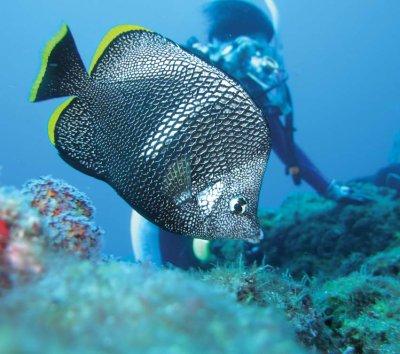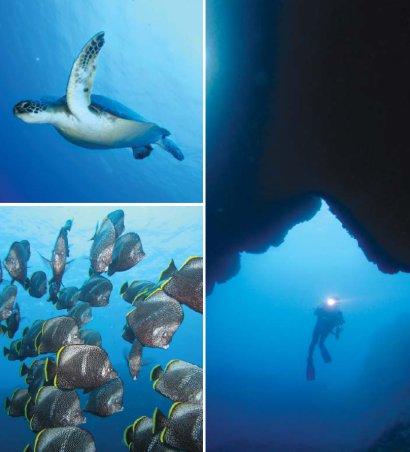Tokyo’s Secret Scuba
The best dive this side of Izu
By Sarah Noorbakhsh
I was thankful to finally step off the ferry and on to my destination. Not because I was eager to leave the Sarubia Maru, whose spacious quarters had been my home for the overnight voyage, but because I had been staring at Hachijo-jima in the distance for the past half hour and was impatient to see what awaited on this small island. We docked and I was met by the welcoming smile of Yoshiyuki Ooishi, long time island resident and dive shop owner. The weather had cleared up from the previous day’s rainstorm, and the blue sky peered down as we cut straight across the gourd-shaped island down palmlined roads. With mild westerly breezes, it was a perfect day for diving.
 Wrought Iron Butterfly Fish
Wrought Iron Butterfly Fish
Of the seven islands in the Izu Island Chain, Hachijo-jima is the furthest at 300 kilometers south of Tokyo. But don’t be fooled by distance; this tiny tropical paradise created by two now inactive volcanoes is still part of Tokyo Prefecture. Around 8,500 residents make their home here, and the island is blessed with rolling green hills across which stretch winding country roads. Life is slow, calm and relaxed. The warm atmosphere belies the islands’ history of Edo period exiles and World War II prisoners. All that remains are a network of war tunnels and walls of peculiar round stones built by convicts—one stone in exchange for one onigiri—and Hachijo is now a quiet little haven of hiking trails, waterfalls, onsen, and diving spots.
“The water is freezing today,” lamented Ooishi. He explained how the Kuroshio Current, which normally gifts the island with tropical waters year-round, had been pushed away by a low-pressure system leaving behind unusually chilly waters. Even so, as we slowly waded into Kaminato Harbor warm water lapped at our wetsuits welcoming us in. The land beneath the surface belayed the harbor’s humble appearance yet suited the atmosphere of Hachijo-jima. A rainbow of colors, fish of all shapes and sizes lazed past, gracefully meandering about as if to mimic the slow life of the islanders themselves.
Moving a few meters deeper, stretches of sand pecked by volcanic rock camouflaged hundreds of box fish who peered suspiciously up with green eyes. Schools of wrought iron butterfly fish darted back and fourth in the clear water; the island is renowned for these yuzen tama (butterfly fish clusters) as well as for its varieties of butterfly and angelfish. I swam toward a cluster of rocks, coral lined with bright red kelp forming a corridor across the sea bed. Upon closer examination, I spotted a brightly colored mantis shrimp making its best attempt to edge out of my view.
Ooishi led me on towards a grove of sea plants stacked upon black volcanic stone and handed me the camera as he searched for some of Hachijo’s exotically neon sea slugs. I got carried away snapping photos of everything that moved, trying in earnest to focus on the yellow butterfly fish waving in the current. And I thought photography on land could be challenging! The sun shined down hard from the surface and illuminated the clear blue salt water as I drifted onward, relaxed by the weightlessness and sound of the sea pushing in on my ears. Ahead swam what looked like bumble bees with long white streamers atop their heads. Moorish idols, a perfect photo opportunity! But as I ventured out to catch them, Ooishi beckoned me back with a touch on the arm and my subjects continued into waters too dangerous for a beginner such as myself.
 Butterfly fish clusters and green sea turtle -- All photos courtesy of Bientos
Butterfly fish clusters and green sea turtle -- All photos courtesy of Bientos
After a quick shower and Italian for lunch— we would save Hachijo’s famous shimazushi and kusaya for dinner, Ooishi led me to several of his favorite spots where he often guides more experienced divers. The beaches all around the island are lined with deep red and black volcanic boulders; ancient seismic activity has created gorgeous natural sculptures both above and below the surface. But what makes for bad sunbathing provides excellent diving, and Hachijo’s seven beach diving points are like virtual underwater playgrounds.
Our first stop, Nuzumado, is one of the top five diving spots in Japan, and its black stone tide pools frame the ocean like an alien landscape. Hachijo is also known for its easy sightings of endangered green sea turtles, which don’t seem to mind the lack of sandy beaches. Hammerhead and thresher sharks also make regular appearances between May and July, and even sun fish can be occasionally spotted in early summer. After cruising down the coast to Ochiyogahama, Ooishi described the underwater arches about 10 meters below. The water here is shallow enough for beginner and intermediate divers, but drops off not far from the shore and creates a variety of terrain to explore. When the waves pick up—as they often do—divers head offshore. There are over 50 boat diving points including those around Hachijo Kojima, which can be seen across a short stretch of ocean.
We moved away from the now choppy sea to one of the island’s many inland hiking spots. After checking out a waterfall nestled in a nearby forest, Ooishi and I trekked up to a peculiar spot of black sand perched on a cliff 200 meters above the coast. Fog rolled in and the sea below looked almost like the Scottish coast. My guide insisted that on a clear day this was a fantastic place to view the sunset but with the white breakers below, almost invisible through the haze, the space felt eerie and calming.
I was eager to take a look at Hachijo-jima’s famed Firefly Canal, but first a much deserved dip in one of the island’s soothing onsen. The sound of women’s murmurs echoing off the steamy walls was relaxing, and I reflected on the day’s experience at a natural wonderland that felt so removed from the prefecture to which it belongs. While regretful that the evening’s clouds obscured a view of the Milky Way impossible to catch in Tokyo City proper, I knew that by morning the winds would bring more fair weather for my outdoor adventure. JI

Sponsored by the Japan National Tourist Organization For more travel information to fully explore Japan visit: www.jnto.go.jp
Hachijo-jima is accessible by ferry with daily service to and from Tokyo. Tokaikisen: www.tokaikisen.co.jp
Regular flights from Haneda Airport are also available four times per day.
Bientos Dive Shop: www.bientos.ne.jp (English available) Information on Hachijo-jima: www.hachijo.info





